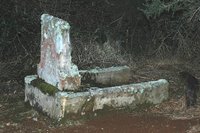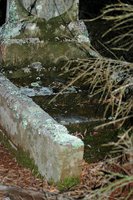This is about the things
which make the Earth live.
By that I mean truly alive.
which make the Earth live.
By that I mean truly alive.
Light, Water, Earth, Air
and the frogs, fish and birds and plants.
Here are some "light study" images
from the trip to Bermagui, last weekend.
At the coast, there is water.
Water changes the light,
and light changes the way we see water.
Water changes the light,
and light changes the way we see water.
Without wishing to start a fight with any of my Darwinian colleagues, I wish to quote several lines from Genesis Chapter 1 (King James Version, of course). The reason is simple - this is part of my culture - these lines are part of my terms of reference - when thinking about light, and water, and the origins of life. I cannot help that - however unfashionable it might seem.It was my starting point. So lets see where this little meditation leads us.
1: In the beginning God created the heaven and the earth.
2: And the earth was without form, and void;
and darkness was upon the face of the deep.
And the Spirit of God moved upon the face of the waters.
3: And God said, Let there be light: and there was light.
 |
| Harsh light - staring into the sun reflected over the Ocean. |
4: And God saw the light, that it was good:
and God divided the light from the darkness.
 |
| Looking out to see, with the sun-light to my left. Morning light at its best |
9: And God said,
Let the waters under the heaven be gathered together unto one place,
and let the dry land appear: and it was so.
10: And God called the dry land Earth;
and the gathering together of the waters called he Seas:
and God saw that it was good.
This Pelican and I agree -
IT IS GOOD!
 |
| Natural light, tweaked a little in processing the contrasts. |
Whether it was done the way Genesis says ???
Well, that is not my view.
Lets move on.
This is already a long-enough "Photo Essay" anyway.
The sign explaining the significance of the "Sacred Waterhole" has been vandalised (stabbed through with a heavy duty hunting knife, in fact) but fortunately someone photographed it before it was damaged. You can read the sign here.
I recommend reading the full story, for it has echoes of the very things I am discussing here, in my Blog essay.
Mumbulla Falls - seen from the viewing platform above.
Click to enlarge the image to see the details.
 |
| Mumbulla Falls (pink granite rock) and the "Sacred Waterhole" |
Immediately beneath these falls was a fast running stream,
where the bubbles I showed yesterday were found.
In the same pool was an Eel -
very hard to see because of the distortion of light and water.
But alive it most certainly was -
swimming left and right
in this fast running water.
Light and water create everything we see.
Further down the stream there was a quiet pool
where I was able to take this "reflection shot".
The people were standing across the pool from me, and higher up
on the next rock ledge.
The image has been inverted, otherwise it would not make sense
at the casual glance.
The people were standing across the pool from me, and higher up
on the next rock ledge.
The image has been inverted, otherwise it would not make sense
at the casual glance.
 |
| Reflections in a quiet pool at Mumbulla Falls |
This Striped Marsh Frog
was nearly a victim of its love of water.
This little frog was unable to escape
from the steep-sided Dog Bowl.
was nearly a victim of its love of water.
This little frog was unable to escape
from the steep-sided Dog Bowl.
But David liberated it.
I could not resist the image, though.
Light and dark, water and light together.
Light and dark, water and light together.
(Click to enlarge image)
Further back from the coast,
one finds dark rainforest patches, in deep gullies.
Such sites are perfect for the Coachwood Tree.
For reasons I do not understand the Coachwood always has patches
of soft grey-green colour,
(which I always enjoy looking at),
which seems to come from a microscopic lichen.
My eye was taken by the colour contrast
offered by the single bright red berry of the Morinda vine
against the grey green lichenised bark,
and the moss growing on the Coachwood.
Click to enlarge the image.
Back into the light and water.
Here is a young male Fur Seal seen at Wagonga Inlet, Narooma.
The seals normally reside at Montague Island,
but some have taken to life in the Wagonga Inlet,
where they hang around the boat ramps
and fish cleaning tables, waiting to be fed.
With the size of these animals,
and the numbers of little children who like to watch
the seals and rays feeding
there is a potential accident waiting to happen at Narooma.
There need to be warning signs erected,
and common-sense behaviour guidelines observed.
Make no mistake -
this doe-eyed seal is a powerful wild animal.
this doe-eyed seal is a powerful wild animal.
 |
| Fur Seal, trying to "con" fishermen into feeding it with fish carcasses. |
And my final piece in this
photo essay about "light".
Here is a near-perfect Spiderweb
photo essay about "light".
Here is a near-perfect Spiderweb
(seen in the early-morning light, of course).
(Click to see the details in the web)
This spider is possibly the "Bush Orb Weaver",
and the fact that the Spider was quite small,
and its web was very delicate.
It was clearly was not one of the much larger Orb Weaver spiders
whose webs are very strong,
(and often golden in colour - which this definitely was not).
Those webs can be quite scary when one walks through them
and then (shock horror) discovers that
one is carrying the large spider on your chest.
This little spider was safely left undisturbed.
 |
| Possibly a Bush Orb Weaver (Araneus eburnus) |
Fortunately, I was able to avoid
this gorgeous little Orb Weaver.
I left her in peace, delicately weaving her web
producing the silken web with her spinnerets
and positioning it with her back legs.
Spider webs are
some of the finest textures
we can see with our poor human eyes.
Insects and spiders, of course, would find that laughable.
But it comes back to my point about light.
Walking towards the early-morning sun
I could easily discern the spiders web
catching the light on the fine fibres.
But when returning to the car,
(with my back to the sun)
I had to be very careful to remember where the web was located
or else I would have walked straight through it
without seeing a thing.
Spiders, Plants, Frogs, Seals, Birds
all depend on
Light and Water;
Air and Earth.
We need to treasure these elements
lest we lose everything.
This is our role in the universe
to be the custodians.
We risk being the destroyers instead.
Let us learn from observing
the importance of light and water.


























